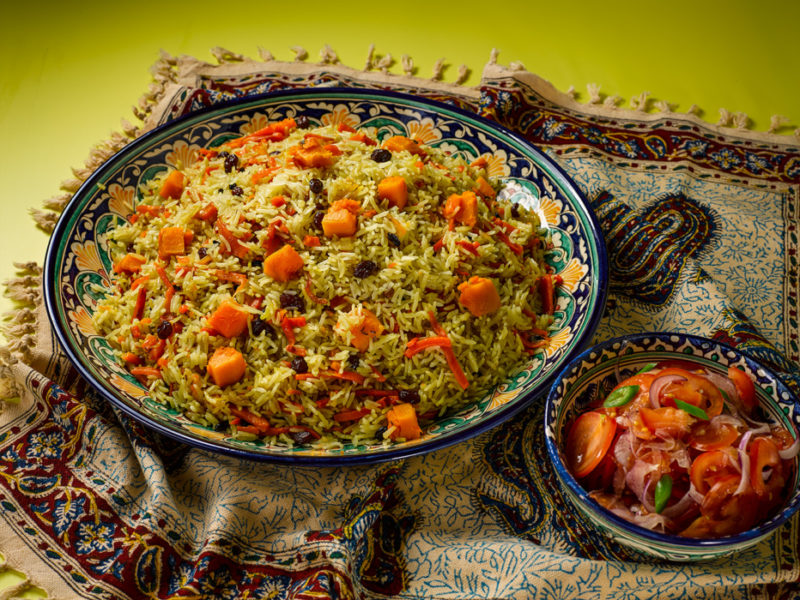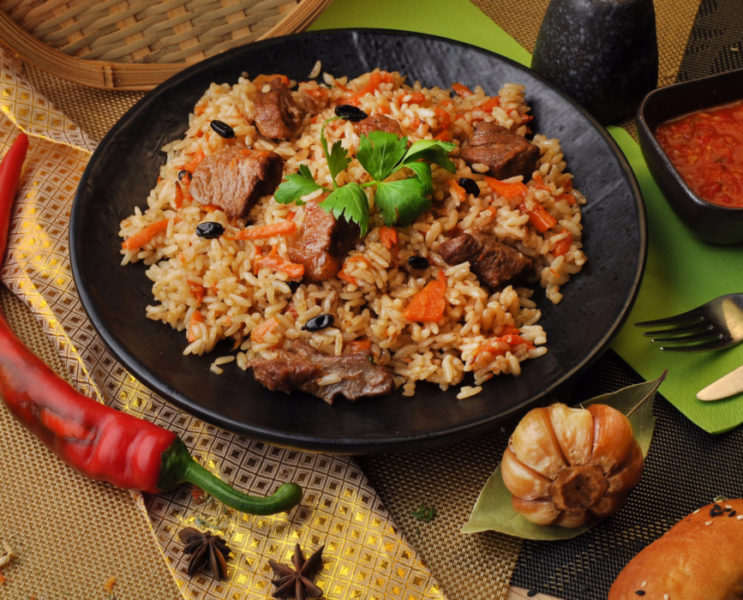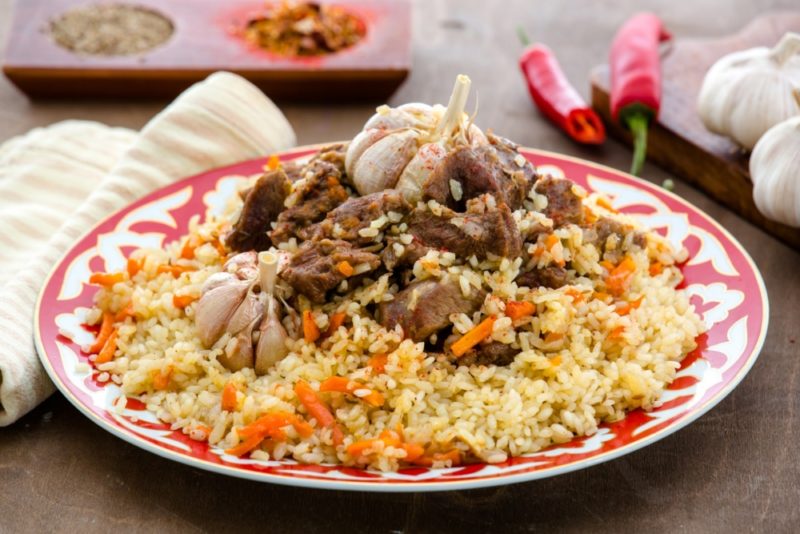Calorie pilaf can be determined without difficulty, if you know its composition. After all, oriental food is prepared both as dietary food and as a very nutritious dish.
Material Content:
Chemical composition and nutritional value
Pilaf is a multi-component meal. The main ingredients of the classic recipe are rice and meat. Carrots, onions, garlic, vegetable and animal fats are also added to the dish.
The main composition of the dish:
- proteins and lipid compounds;
- dietary fiber, organic acids;
- carbohydrates, including starch, mono - and disaccharides.
Nutrient foods with valuable nutrients enrich pilaf with vitamins A, E, C, PP, H, as well as almost all representatives of group B. Minerals, micro and macro elements are present in it. In particular, calcium, zinc, phosphorus, molybdenum, selenium, chlorine, manganese, cobalt, copper and others.
Calorie content and BJU pilaf depending on the recipe
The nutritional value of the ingredients of the dish affects how many calories in pilaf.
Approximate calorie values of various products:
| Name of pilaf ingredients | Calories, kcal per 100 g |
|---|---|
| Main components | |
| Carrot | 37 |
| Onion | 40 |
| Garlic | 140 |
| Rice | |
| boiled | 115-140 |
| brown (dry product) | 335 |
| round (dry product) | 340 |
| long steamed (dry product) | 360 |
| Animal fat | 895 |
| Vegetable oil | 900 |
| Different types of meat | |
| veal | 88 |
| chicken fillet | 100 |
| beef (lean) | 126 |
| veal (oily) | 145 |
| lamb (lean) | 170 |
| chicken (fatty) | 195 |
| pork | 250 |
| beef (fat) | 260 |
| lamb (fat) | 290 |
| pork (fatty) | 420 |
| Additional components | |
| Mushrooms | 22 |
| Tomatoes | 23 |
| Dried apricots | 230 |
| Prunes | 255 |
| Bay leaf | 310 |
During cooking, rice absorbs a lot of water, so the calorie content of 100 grams of the finished product is significantly reduced. The type of meat that was used, its quantity and fat content will significantly affect the nutritional value of the dish.And also on what the ingredients were stewed, how much vegetable or animal fat was used. The average calorie content of 100 g pilaf is from 160 to 190 kcal. The nutritional value of various types of food is presented in the table.
| The basis of pilaf | Calories 100 g, kcal |
|---|---|
| with mushrooms (no meat added) | 95 |
| on turkey meat | 140 |
| on chicken | 150 |
| on chicken legs | 185 |
| on lamb | 190 |
| on duck meat | 205 |
| on beef | 230 |
| on pork | 315 |
According to the classic recipe, pilaf is prepared from 2 glasses of rice, 0.5 kg of lamb, half a glass of sunflower oil, 150 g of onions and 150 g of carrots. In 100 grams of such a meal, about 155 calories. If you use beef instead of lamb in the basic recipe, then the nutritional value of 100 g of prepared pilaf will be approximately 195 kcal.
Calorie pilaf with chicken or turkey is the lowest - about 145 calories in 100 g.
The proportions of the ingredients can seriously change the nutritional properties of food:
- Bay leaf has a high calorie content, but its quantity in the dish is very small, so the product will not harm even with a diet.
- Sometimes in the pilaf use dried fruits, for example, dried apricots or prunes. They will add calories, but give the dish an original taste, saturate with useful vitamins and minerals.
- Excess carrots, mushrooms or onions will increase nutritional value slightly. And if you do not use meat, the dish will become a low-calorie diet food.
As a percentage, most pilaf contains carbohydrates. In the second place are fats, the amount of protein is relatively small. BZHU (approximate ratio of components) - 1 g of protein accounts for 1.8 g of fat and 4.5 g of carbohydrates. For example, in a dish prepared with lamb according to the classic recipe, there will be 7 g of protein, 11 g of fat and 27-29 g of carbohydrates. It is difficult to say regarding the varieties of this dish, because each housewife prepares pilaf in her own way. In such a situation, it is worth using a calorie analyzer, which can be found on the Internet.
What is useful dish
Pilaf made from quality products has a beneficial effect on the body.
Rice and meat based dishes contain such beneficial substances:
- Protein compounds. They are quickly absorbed and give a feeling of satiety. They participate in the formation of muscle tissue and blood formation processes, lipid metabolism, improve brain activity.
- Vitamins They support immunity, stabilize the functioning of organs and systems. Potassium reduces puffiness, removes excess fluid from the body, and prevents the development of cardiovascular problems. B vitamins help maintain vision, improve the condition of the skin and hair, and normalize the neuropsychic state. Vitamin A is involved in the synthesis of hormones and enzymes.
- Cellulose. It has absorbing abilities, removes toxins from the body.
- Biologically active elements and volatile onion and garlic. They increase resistance to infections and colds, improve intestinal microflora, and prevent pathological processes in the gastrointestinal tract.
Rice must be used quality, preferably long. Of particular value are brown varieties of the product. They are recommended for those who monitor their weight or want to lose weight. Dark rice is less calorie, contains high doses of unsaturated fats. Subject to a diet, prepare lean pilaf, without fatty meat and a large amount of oil.
Rice contains no gluten. Pilaf can be eaten by those who suffer from gluten intolerance, cannot eat cereals from other cereal crops - rye, barley, wheat. Enveloping substances in the composition of the product help improve the condition of gastritis and peptic ulcer disease, reduce the likelihood of developing malignant tumors.
Lamb has a relatively high calorie content, but it is recommended to use it in pilaf. This is a unique product that has 4 times less cholesterol than pork.As well as a high content of lecithins - organic substances that develop memory, regulate metabolism and insulin levels in the blood. Any meat improves the general condition, improves mood and performance.
It is appropriate to add to the pilaf not only traditional vegetables - onions, carrots and garlic. Green peas, tomatoes, bell peppers can make the product more useful. Indian versions use potatoes.
Pilaf gains a special taste and aroma thanks to spices - ground pepper, saffron, caraway seeds, barberry and others. Seasonings have a rejuvenating effect on the human body, strengthen it, restore the structure of cells.
Contraindications
Fans of low-calorie foods sometimes replace meat in pilaf with a small amount of dried fruits. Such a dish is undesirable to use in diabetes mellitus, diseases of the gastrointestinal tract, liver and pancreas. It is appropriate to add dried fruits to people who suffer from frequent constipation.
Moderate portions of pilaf in the diet will benefit the body. Overeating can cause heaviness in the stomach, heartburn. Rice dish is not recommended to eat at night, it is advisable to use it in the morning or for lunch.
For allergies, use spices with caution. It is not recommended to abuse ready-made multi-component seasonings, which often contain low-quality ingredients.
Pilaf is a national dish, pride and a “visiting card” of oriental cuisine. Tasty food is appropriate to use even when losing weight. It is enough to choose low-calorie foods for its preparation.















